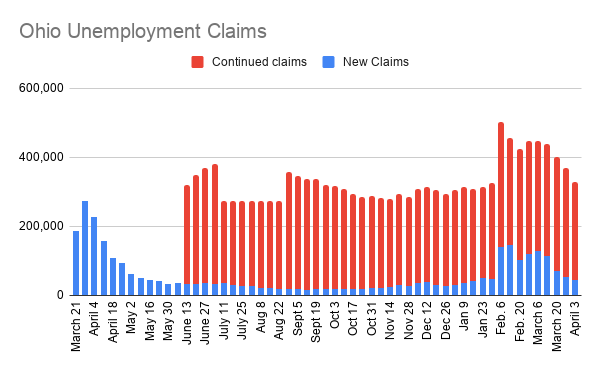New Unemployment Claims in Ohio Drop for 5th Straight Week
YOUNGSTOWN, Ohio – The number of new unemployment claims filed in Ohio fell for the fifth straight week, as 44,985 claims were submitted the week ended April 3.
The previous week, there were 54,343 new claims filed, according to the Ohio Department of Job and Family Services.
About 5,000 claims were flagged for potential fraud, the agency said. Those who believe their identity has been used to file fraudulent unemployment claims can call 833 658 0394 or use the “Report Identity Theft” button at Unemployment.Ohio.gov.
There were also 283,201 continued unemployment claims filed last week in Ohio, down about 31,500 from the previous week. Continued claims have fallen for three straight weeks.
In the 55 weeks since the effects of the pandemic started to be felt in Ohio, the state has disbursed $9.3 billion in unemployment compensation to more than 984,000 people, as well as $10.1 billion in pandemic unemployment assistance, given to those who don’t qualify for traditional unemployment such as part-time workers and the self-employed, to more than 1 million people.

The Pennsylvania Department of Labor reports 21,571 initial unemployment claims were filed the week ended March 27, up about 2,000 from the previous week.
The Keystone State has paid a total of $39.9 billion in unemployment through the week of April 3, including $7.4 billion in traditional unemployment and $8.5 billion in pandemic unemployment assistance.
Nationwide, the number of people applying for unemployment rose to 744,000 last week, up about 16,000 from the previous week.
For the week ending March 27, 3.7 million people were receiving traditional state unemployment benefits, the government said. If you include supplemental federal programs that were established last year to help the unemployed endure the health crisis, a total of 18.2 million are receiving some form of jobless aid the week of March 20.
Economists monitor weekly jobless claims for early signs of where the job market is headed. Applications are usually a proxy for layoffs: They typically decline as the economy improves. Or they rise as employers retrench in response to sluggish consumer demand.
During the pandemic, though, the numbers have become a less reliable barometer. States have struggled to clear backlogs of unemployment applications, and suspected fraud has clouded the actual volume of job cuts.
By nearly all measures, though, the economy has been strengthening. During March, employers added 916,000 jobs, the most since August, and the unemployment rate declined from 6.2% to 6%. In February, the pace of job openings reached its highest level on record. Last month, consumer confidence posted its highest reading in a year.
And this week, the International Monetary Fund forecast that the U.S. economy will grow 6.4% this year. That would fastest annual pace since 1984 and the strongest among the world’s wealthiest countries.
All of which suggests that employers will keep hiring steadily this year as the broader economy improves. That said, the United States still has 8.4 million fewer jobs than it had in February 2020, just before the pandemic struck. New confirmed coronavirus cases, which had dropped sharply from early January through early March, have plateaued over the past month. In addition, the vaccination rate for elderly Americans, who are among the most vulnerable, has dramatically slowed even as the supply of vaccines has expanded.
And the data firm Womply reports that the percentage of businesses that remained closed last week rose from the beginning of March — from 38% to 45% for bars; from 35% to 46% for beauty shops; and from 30% to 38% for restaurants.
The Associated Press contributed to this story.
Copyright 2024 The Business Journal, Youngstown, Ohio.



